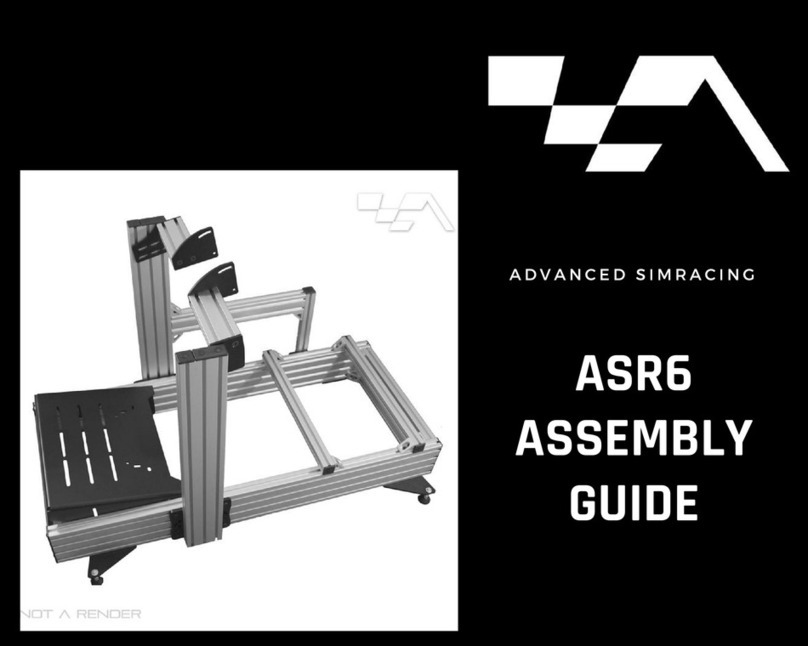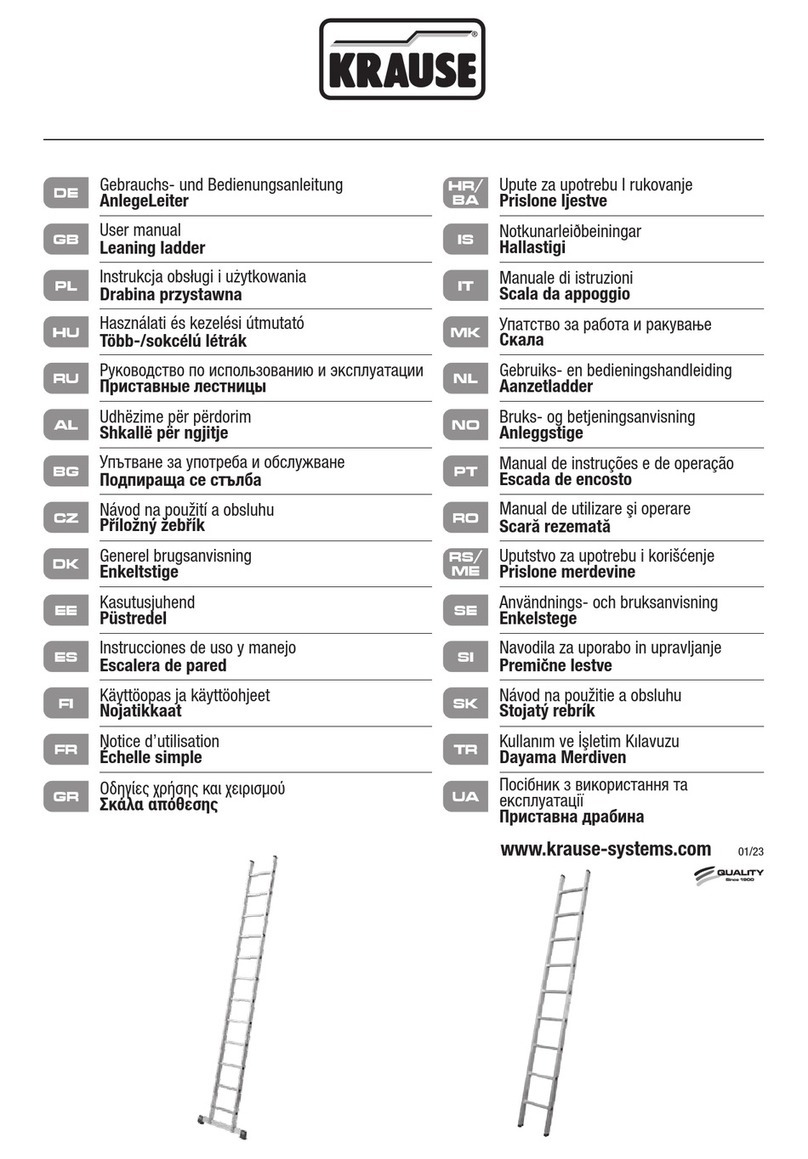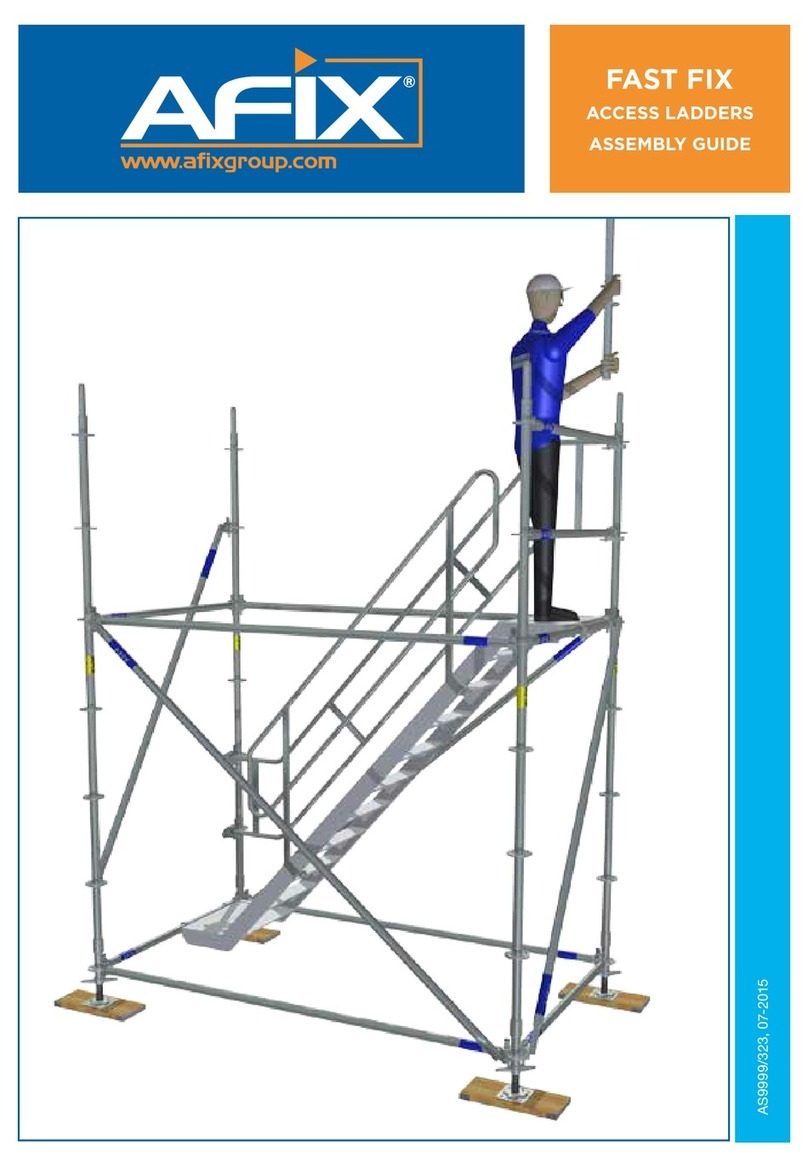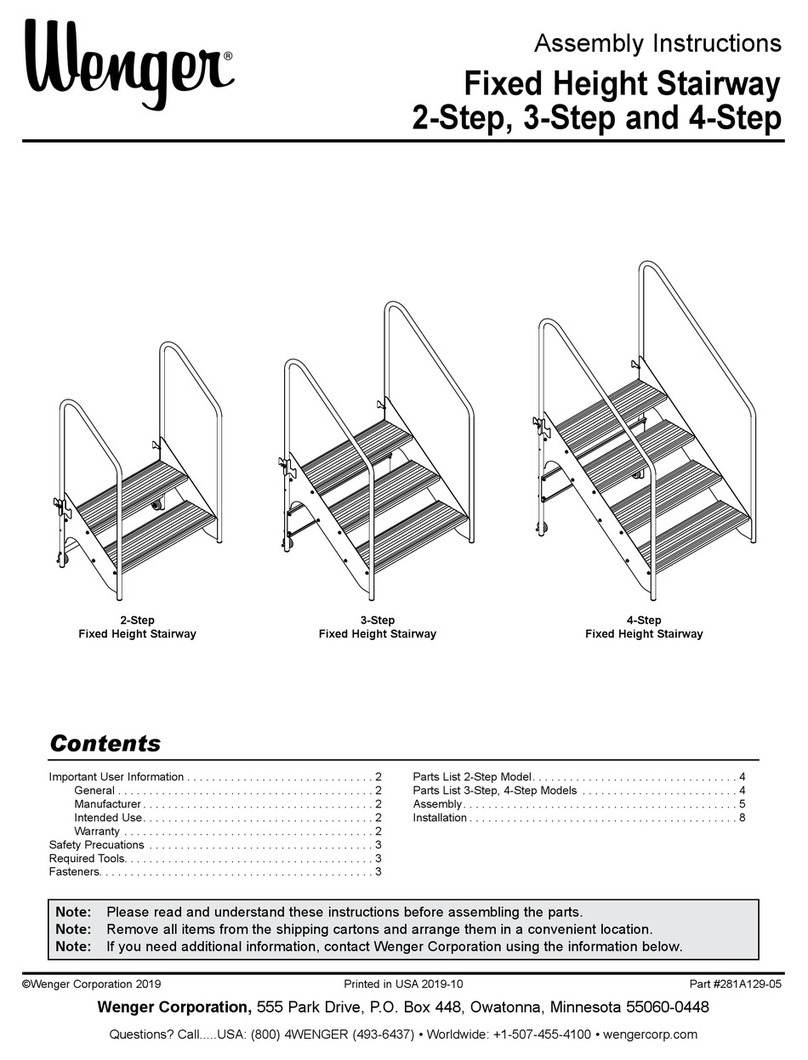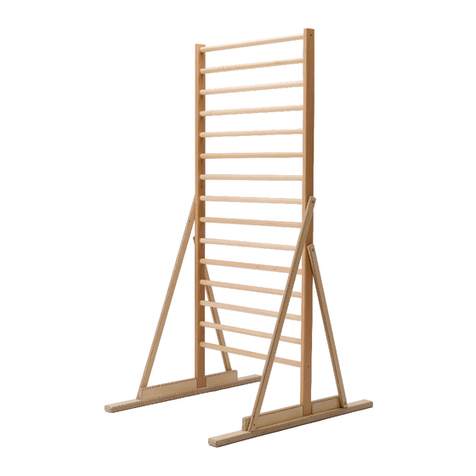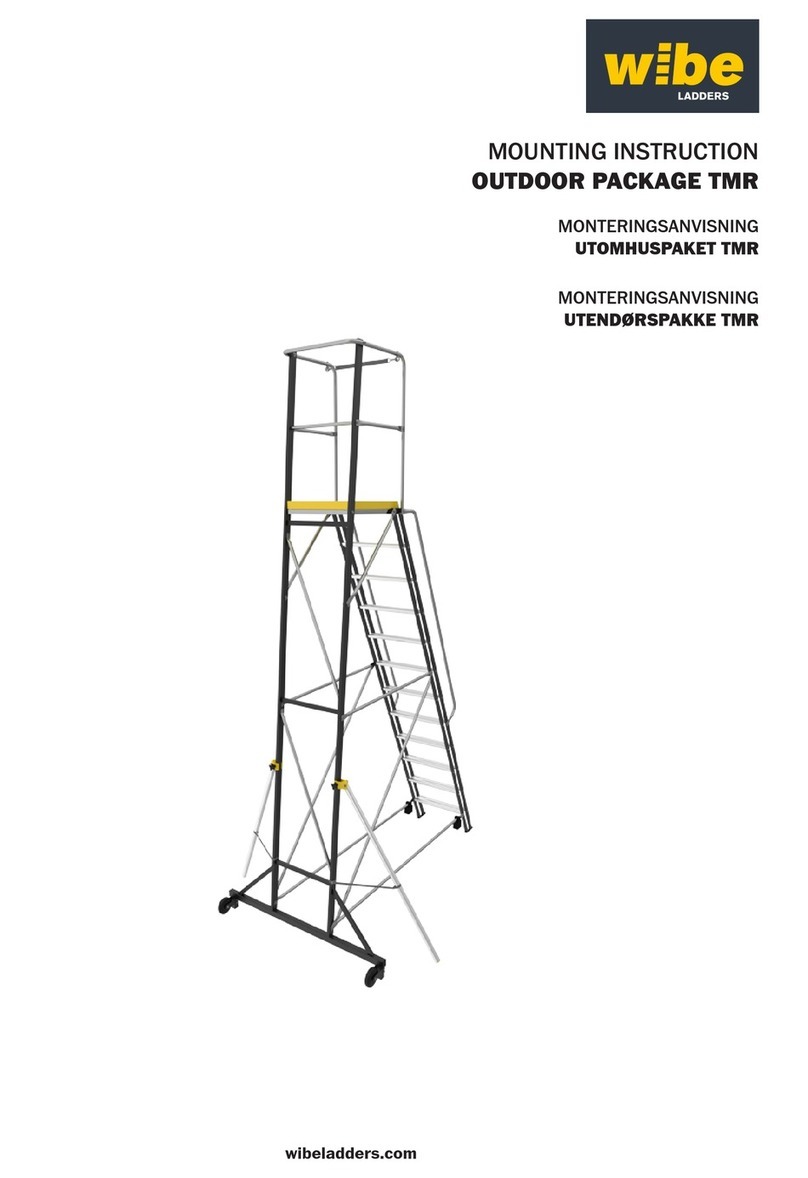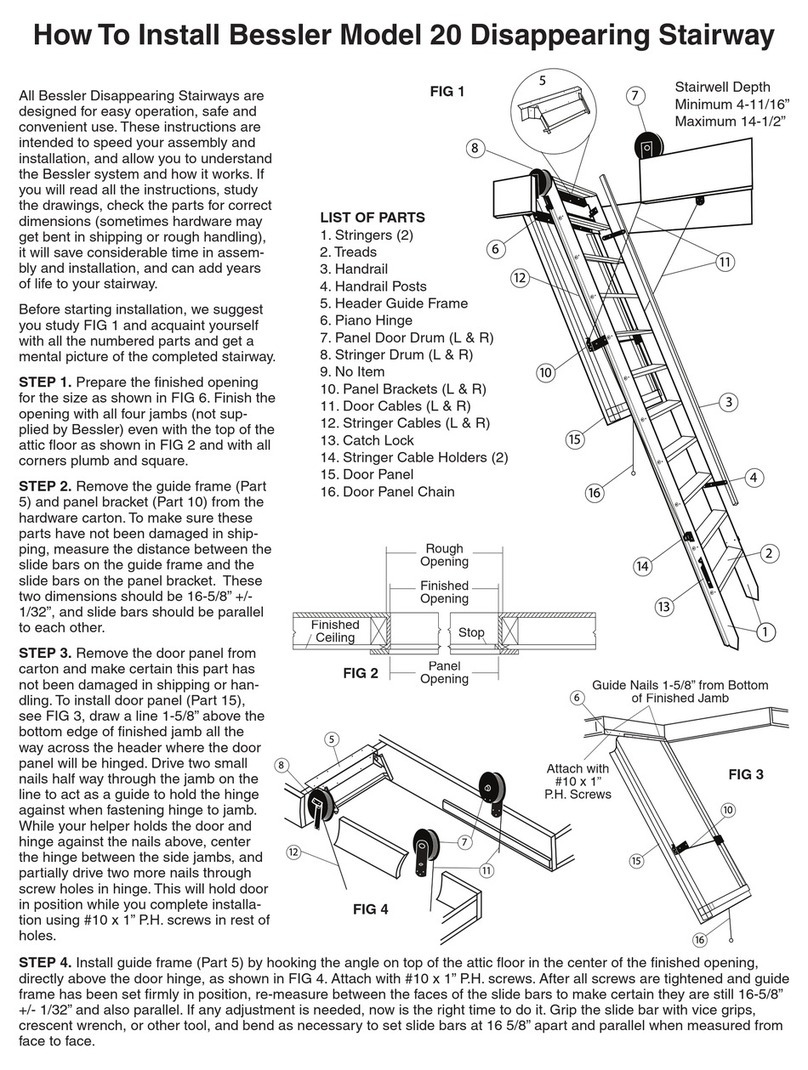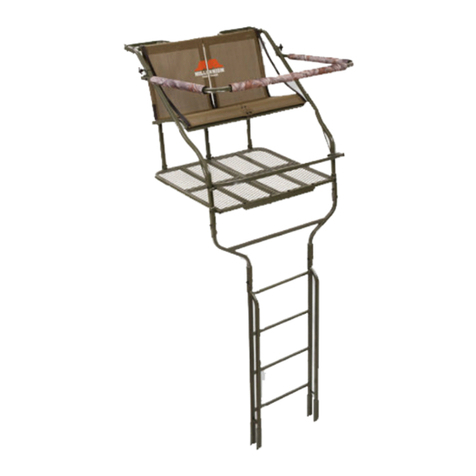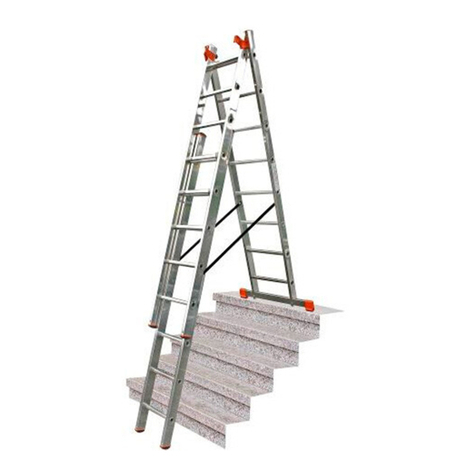
ITA Istruzioni d’uso
1. INTRODUZIONE
Le presenti Istruzioni d’uso descrivono l’utilizzo sicuro delle scale S107/S108/S109/S112 da 3 a 8
gradini.
Il presente manuale di istruzioni contiene importanti avvertenze per la sicurezza, leggere quindi le
presenti istruzioni per intero, rispettando in particolare tutte le avvertenze per la sicurezza prima di
utilizzare la scala.
Le scale soddisfano i requisiti della norma europea EN 131-1-2-3 e sono certificate da TÜV RHEIN-
LAND.
Si prega di conservare il presente manuale di istruzioni, in caso di vendita della scala, le presenti
istruzioni d‘uso devono essere consegnate al nuovo proprietario.
2. USO CONFORME
Questa scala è un mezzo di lavoro mobile utilizzabile in diversi luoghi.
Con questa scala è possibile eseguire lavori di piccola entità ad altezze per le quali l’utilizzo di altri
mezzi di lavoro non risulta adeguato (si veda il testo unico per la sicurezza DLGS 81/08).
Questa scala deve essere utilizzata solo come descritto nelle presenti istruzioni d’uso. Qualunque
uso differente è da considerarsi non conforme.
Non si assume alcuna responsabilità per danni derivanti da un uso non conforme.
Eventuali modifiche alla scala non autorizzate dal costruttore comportano l’invalidamento della
garanzia.
3. INFORMAZIONI TECNICHE
Vedi immagine scala.
4. AVVERTENZE DI SICUREZZA
4.1 Avvertenze generali di sicurezza
Prima di procedere con l’uso, rimuovere il materiale d’imballaggio, verificare l’integrità della scala
(presenza gommini, protezioni laterali gradini) ed eventuali danni da trasporto.
Leggere attentamente le istruzioni d’uso della scala.
•Durante l’utilizzo della scala sussiste di norma il rischio di caduta. Tutti i lavori con e sulla
scala devono pertanto essere eseguiti in modo da ridurre il più possibile il rischio di caduta.
•Durante l’utilizzo della scala sussiste altresì il rischio di ribaltamento. Con un ribaltamento
è possibile causare lesioni a persone e danni a cose. Tutti i lavori con e sulla scala devono
pertanto essere eseguiti in modo da ridurre il più possibile il rischio di ribaltamento.
•I lavori di riparazione e manutenzione alla scala devono essere eseguiti da personale esper-
to e in conformità alle istruzioni del produttore.
Utilizzo della scala in ambiente non lavorativo (uso domestico):
A. Montante anteriore
B. Gradino
C. Montante posteriore
D. Protezione laterale gradino
E. Gommino
F. Etichetta marchiatura scala
G. Predella
H. Guardacorpo
I. Corda di sicurezza (prevista per scale S107/
S108/S112 modelli 6/7/8 gradini)
J. Vaschetta portaoggetti (di serie a seconda
del modello)
• L’utente deve di norma accertarsi che la scala sia idonea
all’uso previsto.
• Per l’impiego commerciale della scala è necessaria una veri-
fica regolare da parte di personale qualificato (DLGS 81/08).
• Il titolare dell’azienda è tenuto a far eseguire regolari controlli
affinché la condizione delle scale sia conforme all’uso (con-
trollo visivo e funzionale). A questo scopo è necessario stabi-
lire modalità, entità e termini dei controlli necessari.
• Gli intervalli di tempo per il controllo dipendono dalle condi-
zioni operative, in particolare la frequenza di utilizzo, il cari-
co durante l‘uso nonché la frequenza e la gravità di eventua-
li difetti riscontrati nei controlli precedenti.
• Il titolare dell’azienda è altresì tenuto a ritirare le scale dan-
neggiate e conservarle per un utilizzo successive solo una
volta eseguita l‘apposita messa a punto o smaltimento.
Utilizzo della scala in ambiente di lavorativo (uso professionale):
4.2 Avvertenze di sicurezza per l’uso della scala
Attenzione, pericolo di
caduta dalla scala.
Attenzione, rischio elettrico.
Individuare tutti i rischi
derivanti da apparecchiature
elettriche nell‘area di lavoro,
ad es. non utilizzare linee
aeree ad alta tensione o altre
apparecchiature elettriche
esposte e non utilizzare
i conduttori se sussiste il
rischio di scossa elettrica
Salire e scendere fronteggiando
sempre la scala.
Non utilizzare scale che
conducono la corrente per
effettuare lavori sotto tensione
o nelle vicinanze di line aeree
elettriche (ad es. scale di
alluminio).
Quando si sale e si scende
tenersi bene alla scala.
Quando si lavora su una scala,
tenersi con una mano o - se ciò
non fosse possibile - utilizzare
ulteriori misure di sicurezza.
Non è consentito scendere
lateralmente dalla scala.
Non utilizzare la scala su un
fondo irregolare o instabile.
Leggere attentamente e
rispettare le istruzioni.
Non utilizzare la scala come
ponteggio.
Carico massimo consentito.
Numero massimo di utenti.
Evitare di sporgersi
lateralmente.
Non utilizzare la scala su
fondi scivolosi o sporchi.
Prima di utilizzare la scala
verificare che non ci siano
eventuali danni che ne
precludano la sicurezza. Evitare di effettuare lavori
pesanti lateralmente, come
ad esempio forare i muri ed il
cemento.
Gli oggetti che si trasportano
su una scala non devono essere
pesanti e devono essere facili
da maneggiare.
Assicurarsi, in base al proprio
stato di salute, di essere in
grado di utilizzare la scala.
Alcune condizioni di salute,
l‘assunzione di farmaci o l‘abuso
di alcool e droghe possono
pregiudicare la sicurezza
dell’utilizzatore di una scala.
Quando si sale su una scala
indossare sempre calzature
idonee.
Non restare troppo a lungo sulla scala senza effettuare regolari pause (la stanchezza costituisce
una fonte di pericolo).
Evitare di danneggiare la scala durante il trasporto, ad es. tramite legacci troppo stretti, e assicura-
re che questa venga fissata / applicata in modo appropriato.
Assicurarsi che la scala sia idonea al rispettivo utilizzo.
Eliminare tutti i segni di sporcizia, come ad esempio vernice umida, sporco, grasso o neve.
Non utilizzare la scala all’aperto in caso di cattive condizioni atmosferiche (ad esempio forte vento,
gelo, neve).
Prima di utilizzare una scala durante il lavoro si dovrà effettuare una valutazione dei rischi (esame
della pericolosità) come previsto dal regolamento aziendale sulla sicurezza sul lavoro.
Quando si posiziona la scala fare attenzione ad evitare possibili collisioni, ad esempio con passanti,
veicoli o porte. Se possibile, bloccare le porte (ad eccezione delle uscite di emergenza) e le finestre
nell‘area di lavoro.
Prima dell’uso assicurarsi che
entrambe le parti della scala
siano completamente aperte
e fisse.
Le scale doppie a un tronco di
salita da chiuse non devono
essere utilizzate come scale da
appoggio.
La scala è idonea
all’utilizzo non
professionale.
La scala è
idonea all’utilizzo
professionale.
Non apportare modifiche alla scala o a parti di essa.
Non movimentare la scala mentre qualcuno la sta utilizzando.
In caso di utilizzo all’aperto, adottare apposite misure contro il vento.
Ispezionare la scala prima di ogni utilizzo tenendo conto di quanto segue:
•verificare che i montanti anteriori o posteriori non presentino piegature, curvature, torsio-
ni, ammacature, incrinature, segni di corrosioni o marcimento;
•verificare che i montanti anteriori o posteriori in prossimità dei punti di fissaggio per gli altri
componenti siano in buone condizioni;
•verificare che non ci siano fissaggi (normalmente rivetti, viti o bulloni) mancanti, alentati o
che presentino segni di corrosione;
•verificare che non ci siano gradini mancanti, allentati o che presentino segni ecessivi di
usura, corrosione o dannegiamento;
•verificare che le cerniere che uniscono la sezione anteriore a quella posteriore non siano
danneggiate o allentate e non presentino segni di corrosione;
•verificare che il dispositivvo di bloccaggio rimanga orizontale e che i montanti posteriori e
i supporti angolari non siano mancanti, piegati o allentati e non presentino segni di corro-
sione o danneggiamento;
•verificare che i piedini in gomma non siano mancanti o allentati e non presentino segni di
eccesiva usura, corrosione o danneggiamento;
•verificare che la scala nella sua integrità sia priva di agenti contaminanti (ad es. sporco, fan-
go, vernice, olio e grasso);
•verificare che i fermi di blocco (se applicati) non siano dannegiati o corrosi e funzionino
corretamente;
•verificare che la piattaforma non abbia parti o fissaggi mancanti e non sia danegiata o cor-
rosa;
Se anche uno solo di questi punti non sia rispettato NON utilizzare la scala.
5. TRASPORTO ED IMMAGAZZINAMENTO
Per evitare danni, la scala deve essere fissata in modo sicuro durante il trasporto (ad es. su porta-
pacchi o all’interno del veicolo).
La scala deve essere immagazzinata in posizione verticale in un ambiente asciutto.
Qualunque danno deve essere escluso e tutte le parti devono essere protette dagli agenti atmo-
sferici.
Immagazzinare la scala in modo tale che sia protetta da bambini che giocano e che non costituisca
un ostacolo per altre persone (ad es. pericolo di inciampamento).
6. MANUTENZIONE E RIPARAZIONE
La cura e la manutenzione della scala ne garantiscono il corretto funzionamento.
La scala deve essere ispezionata regolarmente per individuare eventuali danni. Il funzionamento
delle parti mobili deve essere garantito.
La pulizia della scala, in particolare di tutte le parti mobili, deve essere effettuata immediatamente
dopo l’uso in caso di sporco visibile.
Utilizzare solo detergenti idrosolubili reperibili in commercio.
Non utilizzare prodotti aggressivi e abrasivi.
7. DURATA D’UTILIZZO
In caso di uso conforme e manutenzione regolare, la scala è un mezzo di lavoro di lunga durata.
8. IMBALLAGGIO E SMALTIMENTO
Smaltire la scala in conformità alle disposizioni vigenti.
Non smaltire la scala tra i rifiuti domestici.
Tutti i componenti inclusi l’imballaggio devono essere separati per tipologia.
L’alluminio è un materiale pregiato e deve essere sottoposto al processo di riciclaggio.
Informazioni dettagliate al riguardo sono reperibili presso il comune competente.
9. INFORMAZIONI PRODOTTO
Il presente manuale di istruzioni è disponibile su Internet all‘indirizzo www.colombo-newscal.com
10. ASSISTENZA E RICAMBI
Maggiori informazioni su servizi di assistenza e ricambi possono essere richieste direttamente al
costruttore.
DEU Gebrauchsanweisung
1. EINLEITUNG
Diese Gebrauchs- und Bedienungsanleitung beschreibt die sichere Verwendung der Leitern S107/
S108/S109/S112 vom 3 stufen bis 8 stufen.
Diese Gebrauchs- und Bedienungsanleitung enthält wichtige Sicherheitshinweise, lesen Sie des-
halb diese Anleitung vollständig durch und beachten Sie insbesondere alle Sicherheitshinweise,
bevor Sie die Leiter benutzen.
Die Leitern erfüllen die Anforderungen der Europäischen Norm EN 131-1-2-3 und sie sind TUV RE-
HINLAND bestätigt.
Bitte bewahren Sie diese Gebrauchs- und Bedienungsanleitung auf. Bei Weitergabe der Leiter die-
se Anleitung ebenfalls mitgeben.
2. BESTIMMUNGSGEMAßER GEBRAUCH
Diese Leiter ist ein mobiles Arbeitsmittel, das an unterschiedlichen Orten eingesetzt werden kann.
Mit dieser Leiter können Arbeiten geringen Umfangs in Höhen durchgeführt werden, bei denen die
Verwendung anderer Arbeitsmittel nicht verhältnismäßig ist
(siehe Betriebsmittelsicherheitsverordnung DLGS 81/08).
Diese Leiter darf nur, wie in dieser Gebrauchs-und Bedienungsanleitung beschrieben, verwendet werden.
Jede andere Verwendung gilt als nicht bestimmungsgemäß.
Für Schäden, die durch nicht bestimmungsgemäßen Gebrauch entstanden sind, wird keine Haf-
tung übernommen.
Veränderungen an der Leiter, die nicht vom Hersteller autorisiert sind, führen zum Erlöschen der Garantie.
3. TECHNISCHE INFORMATIONEN
Siehe die Leiter Bild.
A. Stehleiter
B. Stufe
C. Rücksteheleiter
D. Seitliche Stüfenbeschützung
E. Fußkappe
F. Etikette
G. Breiten Stufe
H. Sicherheitsverlängerung
I. Spanngurt (für S107/S108/S112 Leitern,
mod. 6/7/8 Stufen)
J. Werkzeuge Behälter (je nach den Modellen)
4. SICHERHEITSINWEISE
4.1 Allgemeine Sicherheitshinweise
Vor der Benützen, sollte Man alle die Verpackungsmaterialen abnehmen, die Unversehrtheit der
Leiter prüfen (Fußkappen, Seitliche Stüfenbeschützung) und eventuelle Transport Schäden.
Man soll aufmerksam die Benützungshinweise lesen.
• Bei der Benutzung der Leiter besteht grundsätzlich die Gefahr eines Absturzes. Alle Arbeiten
mit und auf der Leiter sind deshalb so durchzufuhren, dass eine Absturzgefahr so gering wie
möglich gehalten wird.
• Bei der Benutzung der Leiter besteht ebenso die Gefahr eines Umsturzes. Durch einen Umsturz
der Leiter können Personen verletz und Gegenstände beschädigt werden.
• Reparaturen und Wartungsarbeiten an der Leiter müssen von einer sachkundigen Person und
den Anleitungen des Herstellers entsprechenden durchgeführt werden.
Benutzung der Leiter im nicht beruflichen Bereich (not professional use):
• Der Benutzer muss grundsätzlich sicherstellen, dass die
Leiter für den jeweiligen Einsatz auch geeignet ist.
• Für den gewerblichen Einsatz der Leiter ist eine regelmassige Über-
prüfung durch eine befähigte Person erforderlich (DLGS 81/08).
• Der Unternehmer hat dafür zu sorgen, dass Mehrzweckleitern
wiederkehrend auf ordnungsgemäßen Zustand geprüft wer-
den (Sicht- und Funktionsprüfung). Hierzu sind Art, Umfang
und Fristen der erforderlichen Prüfungen festzustellen.
• Die Zeitabstände für die Prüfung richten sich nach den Betriebs-
verhältnissen, insbesondere nach der Nutzungshäufigkeit, der
Beanspruchung bei der Benutzung sowie der Häufigkeit und
Schwere festgestellter Mangel bei vorgegangenen Prüfungen.
• Der Unternehmer hat ebenso dafür zu sorgen, dass schad-
hafte Leitern der Benutzung entzogen und so aufbewahrt
werden, dass eine Weiterbenutzung bis zur sachgerechten
Instandsetzung bzw. Entsorgung nicht möglich ist.
Benutzung der Leiter in beruflichen Bereich (professional use):
4.2 Sicherheitshinweise zum Gebrauch der Leiter
Warnung, Sturz von der
Leiter.
Warnung, elektrische
Gefährdung. Alle durch
elektrische Betriebsmittel im
Arbeitsbereich gegebenen
Risiken feststellen,
z.B. Hochspannungs-
Freileitungen oder andere
freiliegende elektrische
Betriebsmittel, und die Leiter
nicht verwenden , wenn
Risiken durch elektrischen
Strom bestehen.
Die Leiter nicht mit
abgewendetem Gesicht auf-
oder absteigen.
Für unvermeidbare Arbeiten
unter elektrischer Spannung
nicht leitende Leitern benutzen.
Beim Aufsteigen, Absteigen
und Arbeiten auf der Leiter gut
festhalten.
Bei Arbeiten auf der Leiter
festhalten oder andere
Sicherheitsmaßnahmen ergreifen,
wenn dies nicht möglich ist.
Seitliches Wegsteigen von
der Stehleiter auf eine andere
Oberfläche ist unzulässig.
Die Leiter nicht auf einem
unebenen oder losem
Untergrund benutzen.
Anleitungen beachten.
Die Leiter nicht als
Überbrückung benutzen.
Maximale Nutzlast.
Maximal Anzahl der Benutzer.
Seitliches Hinauslehnen
vermeiden.
Die Leiter nicht auf
verunreinigtem Untergrund
aufstellen.
Vor jeder Nutzung
Sichtprüfung der Leiter auf
Beschädigungen und sichere
Benutzung.
Arbeiten, die eine seitliche
Belastung bei Leiter bewirken,
z.B. seitliches Bohren durch
feste Werkstoffe, vermeiden.
Bei Benutzung einer Leiter keine
Ausrüstung tragen, die schwer
oder unhandlich ist.
Die Leiter im Fall von
körperlichen Einschränkungen
nicht benutzen Bestimmte
gesundheitliche
Gegebenheiten,
Medikamenteneinnahme,
Alkohol oder Drogenmissbrauch
können bei der Benutzung der
Leiter zu einer Gefährdung der
Sicherheit führen.
Die Leiter nicht mit
ungeeigneten Schuhen
besteigen.
Nicht zu lange ohne regelmäßige Unterbrechungen auf der Leiter bleiben (Müdigkeit ist eine Ge-
fahr).
Beim Transport der Leiter Schaden verhindern, z.B. durch Festzurren, und sicherstellen, dass sie
auf angemessene Weise befestigt / angebracht ist.
Sicherstellen, dass die Leiter für den jeweiligen Einsatz geeignet ist.
Eine verunreinigte Leiter, z.B. durch nasse Farbe, Schmutz, Öl oder Schnee, nicht benutzen.
Die Leiter nicht im Freien bei ungünstigen Wetterbedingungen (z.B. starker Wind) benutzen.
Im Rahmen einer gewerblichen Nutzung Gebrauchs muss eine Risikobewertung unter Berücksich-
tigung der Rechtsvorschriften im Land der Benutzung durchgeführt werden.
Wenn die Leiter in Stellung gebracht wird, ist auf das Risiko einer Kollision zu achten, z.B. mit Fuß-
gängern, Fahrzeigen oder Türen. Türen (jedoch nicht Notausgänge) und Fenster im Arbeitsbereich
verriegelt, falls möglich.
Die Leiter von Benutzung
vollständig offen.
Die Mehrzweckleitern sollten
nicht als Stutzleitern benutzen
werden.
Die Leiter ist für
den beruflichen
Gebrauch geeignet.
Die Leiter ist für den
nicht beruflichen
Gebrauch geeignet.
Die Konstruktion der Leiter nicht verändern.
Während des Stehens auf der Leiter diese nicht bewegen.
Bei Verwendung im Freien Vorsichtsmaßnahmen gegenüber Wind ergreifen.
Um die Leiter vor zu untersuchen, folgt jeder Gebrauch, bitte was folgt in Betracht ziehen:
•prüfen Sie, dass die Stehleitern und Ruckstehleitern Falte, Verbiegen, Drehungen, Quet-
schungen, Fehler, Zeichen von Korrosionen oder Verfaulungen nicht einführen;
•prüfen Sie, dass die Stehleitern und Ruckstehleitern in der Nähe der Punkte des Befesti-
gens für die anderen Bestandteile unter guten Verfassungen sind;
•prüfen Sie, keine Ermangeln-Befestigen (normalerweise Niete, Weinstöcke oder Schraub-
bolzen), schlaff geworden sind, oder dass sie Zeichen der Korrosion einführen;
•prüfen Sie, gibt es keine fehlenden Stufen , gelöst, oder dass sie Zeichen von Wucher, Kor-
rosion oder Schädigen einführen;
•prüfen Sie, werden die Reißverschlüsse, die den vordere Teil zu der Rückseite vereinigen,
nicht beschädigt, oder Sie lockern sich, und führt Zeichen der Korrosion nicht ein;
•prüfen Sie, dass die Blockierungsvorrichtung horizontal darin bleibt, und dass die Ruck-
stehleitern und die winkligen Unterstützungen, nicht fehlenden sind oder Falzen haben
oder Zeichen der Korrosion oder Beschädigung nicht einfuhren;
•prüfen Sie, dass der Gummifußkappen nicht fehlend oder gelöst sind und, Zeichen des
Wuchers, Korrosion oder Beschädigung nicht einfuhren;- prüfen Sie, dass die ganze Leiter
ohne Verschmutzen des Agenten (zu es. schmutzig, Schlamm, Lack, Öl und Fett) ist;
•prüfen Sie, dass die Sperren (wenn angewandt) nicht beschädigt oder korrodierte sind, und
dass korrekt arbeiten;
•prüfen Sie, dass die Grundlage nicht fehlende Teilen oder Befestigen hat und nicht beschä-
digt oder angefressen ist;
Wenn auch nur ein diesen Punkten nicht hochgeachtet wird, bitte benutzen Sie NICHT die Leiter.
5. TRANSPORT / LAGERUNG
Um jegliche Beschädigungen zu vermeiden ist die Leiter beim Transport (z.B. auf Dachträgern
oder im Auto) sicher zu befestigen.
Die Lagerungen der Leiter sollte in einer trockenen Umgebung senkrecht stehend oder flach lie-
gend erfolgen.
Jegliche Beschädigungen müssen ausgeschlossen werden und alle Teile von Witterungsverhält-
nissen geschützt sein.
Die Leiter so lagern, dass sie vor spielenden Kindern geschützt ist und keine Personen behindert
werden (evtl. Stolpergefahr).
6. PFLEGE / INSTANDHALTUNG
Die Pflege und Wartung der Leiter soll deren Funktionstüchtigkeit sicherstellen.
Die Leiter muss regelmäßig auf Beschädigungen überprüft werden. Die Funktion beweglicher Teile
muss gewährleistet sein.
Die Reinigung der Leiter, insbesondere aller beweglichen Teile, sollte bei sichtbarer Verschmut-
zung sofort nach dem Gebrauch erfolgen.
Nur handelsübliche, wasserlösliche Reinigungsmittel benutzen.
Keine aggressiver, scheuernden Mittel verwenden.
7. GEBRAUCHSDAUER
Bei bestimmungsgemäßem Gebrauch und regelmäßiger Wartung ist die Leiter ein langfristig ver-
wendbares Arbeitsmittel.
8. VERPACKUNG / ENTSORGUNG
Wenn die Leiter ausrangiert wird, ist sie zu den aktuellen Bestimmungen zu entsorgen.
Die Leiter darf nicht im Hausmüll entsorgt werden.
Alle Komponenten inkl. Verpackung müssen sortenrein getrennt werden.
Aluminium ist ein hochwertiges Material und kann dem Recyclingprozess wider zugeführt werden.
Detaillierte Auskünfte hierzu erteilt Ihre zuständige Kommune.
9. PRODUKTINFORMATIONEN
Diese Gebrauchs- und Bedienungsanleitung finden Sie im Internet unter
www.colombo-newscal.com
10. SERVICE / ERSATZTEILE
Weitere Informationen zu Serviceleistungen und Ersatzteilen erhalten sie direkt vom Hersteller.
Colombo New Scal S.p.A.
Via Statale, 17
23888 La Valletta Brianza (LC)
ITALY
Tel. +39 039 9274002
Fax. +39 039 5311889
Mail newscal@colombo-newscal.com
www.colombo-newscal.com

